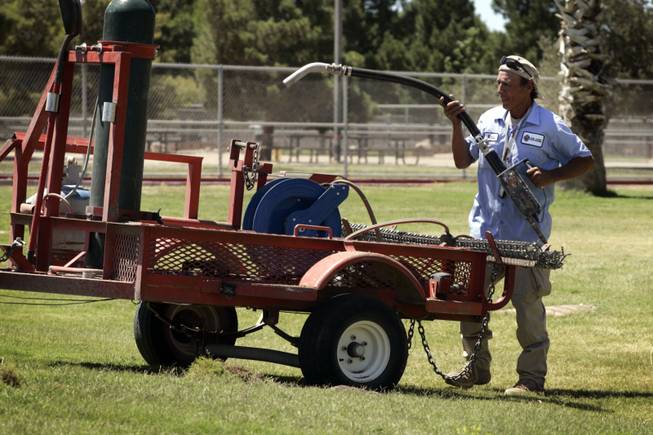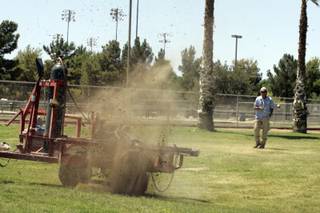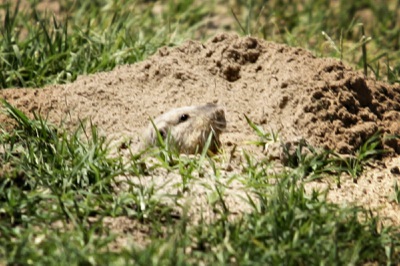
Michael Yakubinis, a program assistant in the Real Property Management Department of Clark County, puts away the Rodenator after blowing up a gopher hole Monday in Sunset Park.
Wednesday, June 23, 2010 | 2 a.m.
Rodenator: Boom! Goodbye Gophers
The gopher infestation - and subsequent bitings and twisted ankles - at Sunset Park in Henderson has led to some drastic measures. Four to five days a week, a park maintenance worker hunts the fields for gopher holes, armed with the newest in humane gopher-killing weaponry: the Rodenator. See it in action in this video: when a worker finds a fresh mound, he uses the long rod of the Rodenator to pump propane into the gopher's burrow, and then "boom!," the gophers have been euthanized.
The problem
Pocket gophers are a longtime nuisance at Sunset Park, pockmarking the landscape with holes and attacking curious visitors.
The solution
After targeting the gopher population with traps and poison, Clark County began using the Rodenator in 2005. The device sets off explosions in gopher burrows.
Beyond the Sun

Steve Sisolak
Map of Sunset Park
“To kill, you must know your enemy, and in this case my enemy is a varmint. And a varmint will never quit — ever. They’re like the Viet Cong — Varmint Cong. So you have to fall back on superior intelligence and superior firepower.”
— Groundskeeper Carl Spackler (Bill Murray) in “Caddyshack”
Clark County officials say they may finally be winning their long-running war against gophers in Sunset Park.
For decades, pocket gophers have pockmarked the park. Countless ankles have been twisted in their holes, and gnawed wiring at the park had to be repeatedly replaced. The gophers were driving parks maintenance people crazy — and driving people away from the sports fields, county officials say.
Kevin Parker, county park manager, says he has seen gophers standing on their hind legs in an attempt to bite county workers. Children bitten by the rodents had to get preventive rabies shots, he says.
County Commissioner Steve Sisolak, whose district includes Sunset Park, says he was told “kids had been bitten when they stuck their hands in the holes.”
All of that is why five years ago the county resorted to the groundskeeper’s version of the nuclear option, the Rodenator.
County park maintenance crews own four of the metal lance-like devices, which cost $1,900 to $2,700 each. They use them to set off oxygen-propane explosions in the gopher burrows. Each Rodenator uses about five to seven gallons of propane per week, which adds up to 300 to 400 gallons a year.
Visitors to the parks on most mornings are liable to hear a warning of “Fire in the hole!” called out before a muffled boom. If they’re close enough, they will feel the ground shiver beneath their feet.
The device sends a concussive shock wave through a gopher burrow at the rate of 5,000 feet per second, according to its manufacturer.
The company’s website shows flames shooting out of the escape-end of an ignited gopher hole.
That’s part of the reason why the animal rights group People for the Ethical Treatment of Animals sent a complaint letter to Clark County about the use of the Rodenator a couple of years ago. A PETA cruelty caseworker wrote that it had gotten complaints from people that “Sunset Park officials are intentionally blasting gopher holes with explosives while the animals are still inside.”
“If these allegations are accurate,” it went on, “we have grave concerns for the welfare of gophers and other animals in the vicinity of Sunset Park.”
Steven Corry, Clark County Parks and Recreation assistant director, says the county has fielded only four or five complaints from park users since the county started using the Rodenator in 2005.
When the county got the PETA letter in November 2008, it stopped using the Rodenator for about 30 days while exchanging e-mails with the animal rights group about other ways to deal with the gopher infestation. How about carbon monoxide poisoning? PETA counteroffered.
Unable to satisfy PETA, the county resumed Rodenation in December 2008 — and has been blasting away, four to five days a week, ever since.
Corry says PETA’s suggested methods “have not been shown to be more humane.”
County officials note that the American Veterinary Medical Association classifies death by concussion as “a humane death.”
“Most public agencies ... utilize traps or poison that are not humane and were discontinued by Clark County when the propane/oxygen method was initiated,” Corry says.
PETA contends the Rodenator can burn and suffocate animals and crush their bones. The organization suggests gophers be humanely evicted from burrows with mothballs, ammonia-soaked rags or peppermint oil-soaked cotton balls.
The problem with that approach is it only moves them to another part of the park.
Sisolak equates the gophers to rats — and so do state statutes. They define the gopher as a “vertebrate pest” right alongside rats and mice. Sisolak says exterminating the gophers is justified because of the reports of bites and because they do so much damage.
“They can move two tons of dirt in a year and create 200 mounds, and those mounds are huge,” he said.
Taxpayers wind up footing the bill for gopher damage.
But how effective is the Rodenator? It’s hard to know how many gophers are killed, because getting a body count would entail digging up the collapsed tunnels to find all the casualties.
Corry says the county have killed thousands of the gophers each year. Parker, who has worked for the parks department for more than 20 years, said the county used to cut into the burrows and tried poison and traps.
“This is certainly the best thing we’ve used,” he says.
“The lack of new mounds and tunnels indicates (the Rodenator’s) effectiveness,” Corry says.
The real test of the Rodenator’s success comes not from e-mails between government employees and not-for-profit groups, but from the mouths of people at the front lines of the county’s gopher war.
Soccer and softball players are returning to Sunset Park’s fields to play because the ground is smooth once again, Parker says.
Carl Spackler would be proud.



Join the Discussion:
Check this out for a full explanation of our conversion to the LiveFyre commenting system and instructions on how to sign up for an account.
Full comments policy